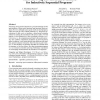192 search results - page 21 / 39 » Using Call Exit Analysis for Logic Program Transformation |
TCAD
2008
13 years 7 months ago
2008
Functional correctness is a vital attribute of any hardware design. Unfortunately, due to extremely complex architectures, widespread components, such as microprocessors, are often...
ICFP
2005
ACM
14 years 1 months ago
2005
ACM
Narrowing-driven partial evaluation is a powerful technique for the specialization of (first-order) functional and functional logic programs. However, although it gives good resu...
PLDI
2004
ACM
14 years 1 months ago
2004
ACM
The design of concurrent programs is error-prone due to the interaction between concurrently executing threads. Traditional automated techniques for finding errors in concurrent ...
FMCAD
2004
Springer
14 years 1 months ago
2004
Springer
Abstract. We relate two well-studied methodologies in deductive verification of operationally modeled sequential programs, namely the use of inductive invariants and clock functio...
SIGSOFT
2002
ACM
14 years 8 months ago
2002
ACM
Program slicing is a potentially useful analysis for aiding program understanding. However, slices of even small programs are often too large to be generally useful. Imprecise poi...

